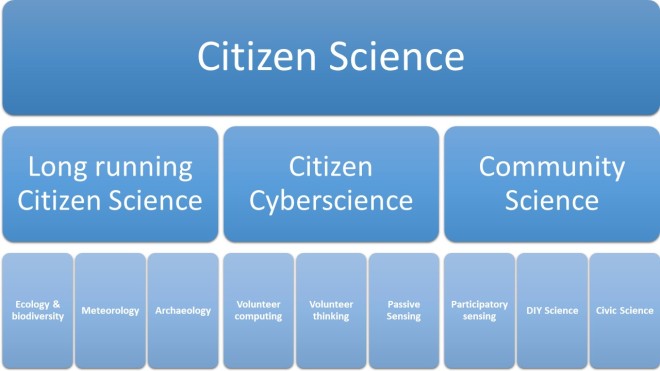Citizen Science for Observing and Understanding the Earth
Since the end of 2015, I’ve been using the following mapping of citizen science activities in a range of talks:

The purpose of this way of presentation is to provide a way to guide my audience through the landscape of citizen science (see examples on SlideShare). The reason that I came up with it, is that since 2011 I give talks about citizen science. It started with the understanding that I can’t explain extreme citizen science when my audience doesn’t understand what citizen science is, and that turned into general talks on citizen science.
Similarly to Caren Cooper, I have an inclusive approach to citizen science activities, so in talks, I covered everything – from bird watching to DIY science. I felt that it’s too much information, so this “hierarchy” provides a map to go through the overview (you can look at our online course to see why it’s not a great typology). It is a very useful way to go through the different aspects of citizen science, while also being flexible enough to adapt it – I can switch the “long-running citizen science” fields according to the audience (e.g. marine projects for marine students).
An invitation for Pierre-Philippe Mathieu (European Space Agency) in 2015 was an opportunity to turn this mapping and presentation into a book chapter. The book is dedicated to “Earth Observation Open Science and Innovation“ and was edited by Pierre-Philippe and Christoph Aubrecht.
When I got to writing the chapter, I contacted two researchers with further knowledge of citizen science and Earth Observation – Suvodeep Mazumdar and Jessica Wardlaw. I was pleased that they were happy to join me in the effort.
Personally, I’m very pleased that we could include in the chapter the story of the International Geophysical Year, (thank Alice Bell for this gem), with Moonwatch and Sputnik monitoring.
The book is finally out, it is open access, and you can read our chapter, “Citizen Science for Observing and Understanding the Earth” for free (as well as all the other chapters). The abstract of the paper is provided below:
Citizen Science, or the participation of non-professional scientists in a scientific project, has a long history—in many ways, the modern scientific revolution is thanks to the effort of citizen scientists. Like science itself, citizen science is influenced by technological and societal advances, such as the rapid increase in levels of education during the latter part of the twentieth century, or the very recent growth of the bidirectional social web (Web 2.0), cloud services and smartphones. These transitions have ushered in, over the past decade, a rapid growth in the involvement of many millions of people in data collection and analysis of information as part of scientific projects. This chapter provides an overview of the field of citizen science and its contribution to the observation of the Earth, often not through remote sensing but a much closer relationship with the local environment. The chapter suggests that, together with remote Earth Observations, citizen science can play a critical role in understanding and addressing local and global challenges.
